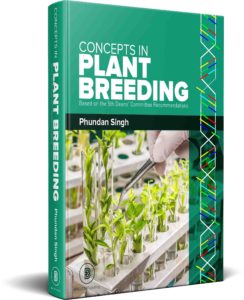Plant breeding plays an important role in genetic improvement of crop plants in relation to their economic use for human being. It is offered as a separate subject both at under graduate and post graduate levels in all Indian agricultural universities. In Plant Breeding several important concepts have emerged after century. However, there is hardly any book which deals with all important plant breeding concepts. The present book “Concepts in Plant Breeding” has been designed to cover all such concepts. The material has been designed to provide comprehensive information about various plant breeding concepts (both conventional and molecular) in one compact volume.
Features:
– The book has been divided into two sections. Section one deals with conventional plant breeding concepts consisting of 13 Chapters [Chapter 1 to 13]. Section two deals with concepts related to molecular breeding consisting of 8 Chapters [Chapter 14 to 21].
– Each chapter has been presented point wise and step by step for easy grasping of students. Chapter wise glossary of technical terms is presented at the end.
– Some useful references are given at the end for gathering further details. List of mutant crop varieties released in India has been appended for ready reference.
Section A
Conventional Plant Breeding Concepts
1. Basic Genetic Concepts
Introduction
Theories
1. Theory Of Natural Selection
2. Mutation Theory
3. Pure Line Theory
Principles/Laws
1. Principle Of Heredity
2. Hardy-Weinberg Law
3. Vilmorin Principle
4. Law Of Parallel Variation
Hypotheses
1. Multiple Factor Hypothesis
2. Gene-For-Gene Hypothesis
3. Dominance Hypothesis
4. Over-Dominance Hypothesis
Inbreeding
Outbreeding
Summary
Questions
2. Transgressive Breeding
Introduction
Main Features
Types Of Transgressive Segregants
Transgressive Segregation
Genetic Causes Of Transgressive Segregation
Testing For Transgressive Segregation
Breeding Procedure
Factors Affecting Trannsgressive Segregation
Examples Of Transgressive Segregation
Advantages
Disadvantages
Summary
Questions
3. Introgressive Breeding
Introduction
Main Features
Types Of Gene Introgression
Factors Affecting Gene Introgression
Role Of Gene Introgression
Limitations Of Gene Introgression
Summary
Questions
4. Participatory Plant Breeding
Introduction
Main Features
Types Of Participatory Plant Breeding
Comparison Of Participatory Varietal
Selection And Ppb
Goals Of Participatory Plant Breeding
Situation To Use Ppb
Comparison Of Participatory And Conventional
Plant Breeding
Advantages Of Ppb
Degrees Of Participation
Role Of Farmers In Ppb
Summary
Questions
5. Maintenance Breeding
Introduction
Areas Of Plant Breeding
Maintenance Procedures
Advantages Of Maintenance Breeding
Limitations
Summary
Questions
6. Ideotype Breeding
Introduction
Main Points
Ideotype Bareeding
Features Of Crop Ideotypes
Factors Affecting Ideotypes
Steps In Ideotype Breeding
Practical Achievements
Merits And Demerits
Future Prospects
Summary
Questions
7. Breeding For Machine Harvesting
Introduction
Main Points
Main Features
Plant Traits Suitable For Machine Harvesting
Steps In Ideotype Breeding
Breeding Methods
Practical Achievements
Merits And Demerits
Future Prospects
Summary
Questions
8. Breeding For Climate Change
Introduction
Factors Associated With Climate Change
Effects Of Climate Change
Climate Change And Breeding
Sources Of Resistance
Breeding Approaches
Screening Techniques
Future Breeding Goals
Practical Achievements
Summary
Questions
9. Breeding For Multiple Cropping Systems
Introduction
Terminology
Choice Of Species And Cultivars
Desirable Plant Traits For Multiple Cropping
Sources Of Desirable Traits
Breeding Methods
Screening Techniques
Examples Of Multiple Cropping Systems
Improving Multiple Cropping Systems
Advantages
Limitations
Questions
10. Breeding For Quality Traits
Introduction
Quality Traits
Nutrition And Nutrients
Nutritional Quality Of Cereals And Pulses
Objective Of Quality Breeding
Genetics Of Nutritional Traits
Sources Of Nutritional Quality
Breeding Methods
Screening Techniques
Breeding For Low Toxic Substances
Practical Achievements
Limitations
Questions
11. Space Breeding And Shuttle Breeding
A. Space Breeding
Introduction
Brief History
Principle Involved
Purpose
New Varieties Developed
Characters Improved
Period Of Exposure
Nuclear Radiation
Effects Of Space Radiation
Advantages
Limitations
B. Shuttle Breeding
Introduction
Concept Developed
Application
Advantages
Summary
Questions
12. Apomixis In Plant Breeding
Introduction
Main Features
Apomixis Versus Amphimixis
Classification Of Apomixis
Causes Of Parthenogenesis
Induction Of Parthenogenesis
1. Apogamy
2. Apospory
3. Adventive Embryony
Recurrent And Non-Recurrent Apomixis
Role Of Apomixis In Plant Breding
Limitations Of Apomixis
Summary
Questions
13. Line And Multiline Breeding
1. Line Breeding
Main Features
Merits And Demerits
Multiline Breeding
Introduction
Main Features
Types Of Multiline
Steps In Development
Merits And Demerits
Achievements
Summary
Questions
Section B
Molecular Breeding Etc.
14. Molecular Breeding
Introduction
Main Features
Areas Of Molecular Plant Breeding
(I) Smart Breeding
(Ii) Transgenic Breeding
Smart Breeding Vs Transgenic Breeding
Involvement Of Other Disciplines
History Of Molecular Breeding
Practical Achievements
Practical Applications
(I) Molecular Marker Technology
(Ii) Gene Technology
Summary
Questions
15. Smart Breeding
Introduction
Main Features
Marker Assisted Selection
Main Points Related To Marker Assisted Selection Are Listed Below
Gene Vs Marker
Selection For Major Gene Linked To Marker
Situation For Use Of Mas
Steps Involved In Mas
Single Step Mas And Qtl Mapping
High-Throughput Genotyping Techniques
Applications Of Markers
Advantages Of Mas
Disadvantages Of Mas
Summary
Questions
16. Reverse Breeding
Introduction
Important Features
Steps Involved
Forward And Reverse Breeding
(I) Forward Breeding
(Ii) Reverse Breeding
Practical Applications
Reverse Breeding And Marker Assisted Breeding
Limitations
Doubled Haploids
Chances Of Finding Complementing Parents
Future Scope
Summary
Questions
17. Transgenic Breeding
Introduction
Steps Involved
Advantages Of Transgenic Technology
Transgenic Plants
Transgenic Vs Conventional Breeding
Applications Of Transgenic Technology
Practical Achievements
Probable Risks Of Plant Biotechnology
Future Scope
Summary
Questions
18. Introduction To Genomics
Introduction
Types Of Genomics
Classification
Proteomics
Metabolomics
Genomics In Crop Plants
Genome Mapping In India
Gene To Be Mapped
Some Genome Mapping Laboratories
Applications In Crop Improvement
Achievements
Limitations
Future Thrusts
Summary
Questions
19. Gene Revolution
Introduction
Main Features
Green Revolution And Gene Revolution
1. Science And Technology
2. Funding Sources
3. Places Of Green Revolution
4. Policies And Political Motivation
Advantages
Future Scope
Summary
Questions
20. Nanotechnology In Crop Improvement
Introduction
Main Features
Brief History
Applications
(I) Application In Crop Improvement
(Ii) Application In Agriculture
(Iii) Applications In Other Fields
Implications Of Nanotechnology
Summary
Questions
21. Evolution Of Crop Plants
Introduction
Types Of Evolution
Genetic Basis Of Evolution
Evolution Of Some Crop Plants
Summary
Questions
Appendices
Glossary (Chapter Wise)
Key References


